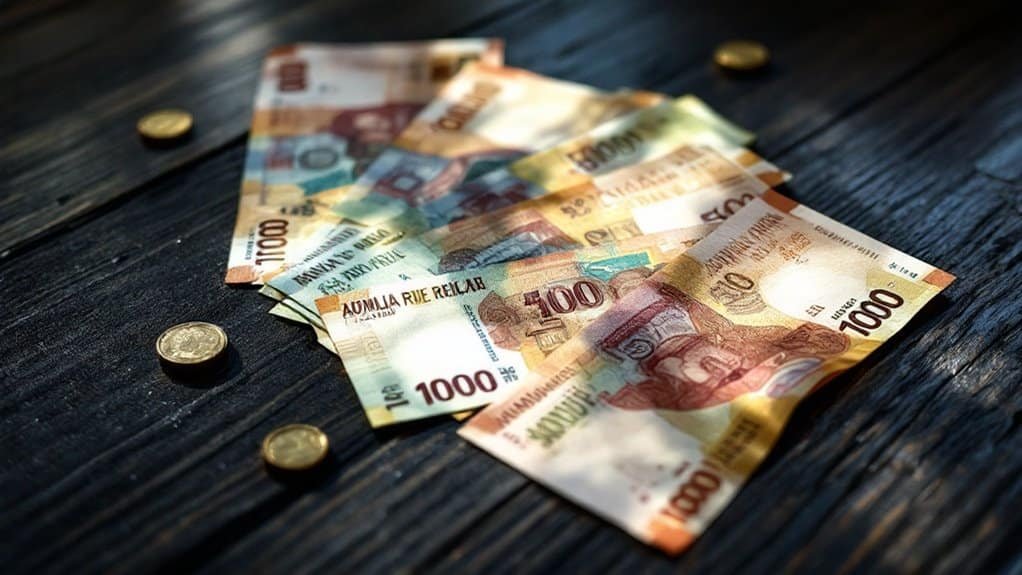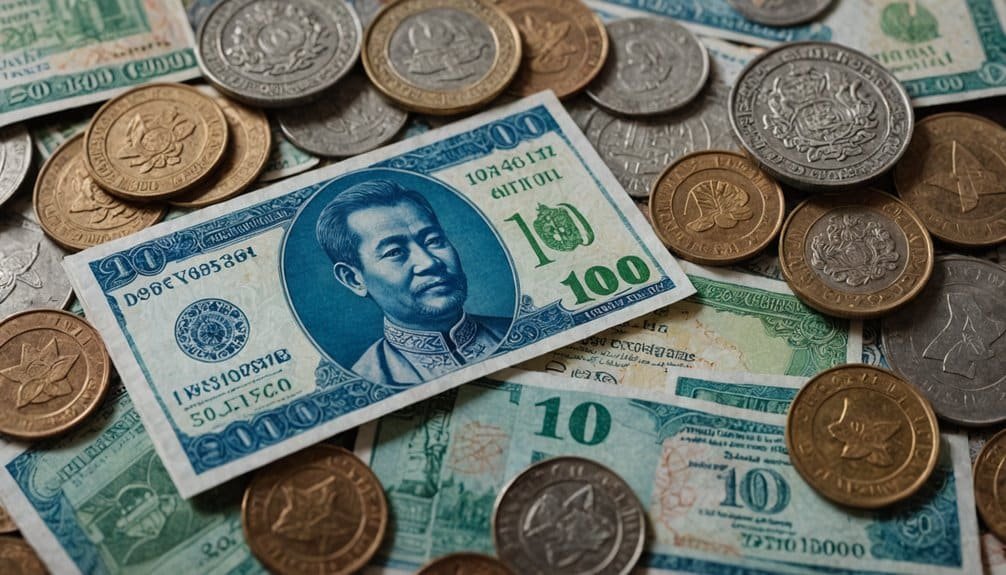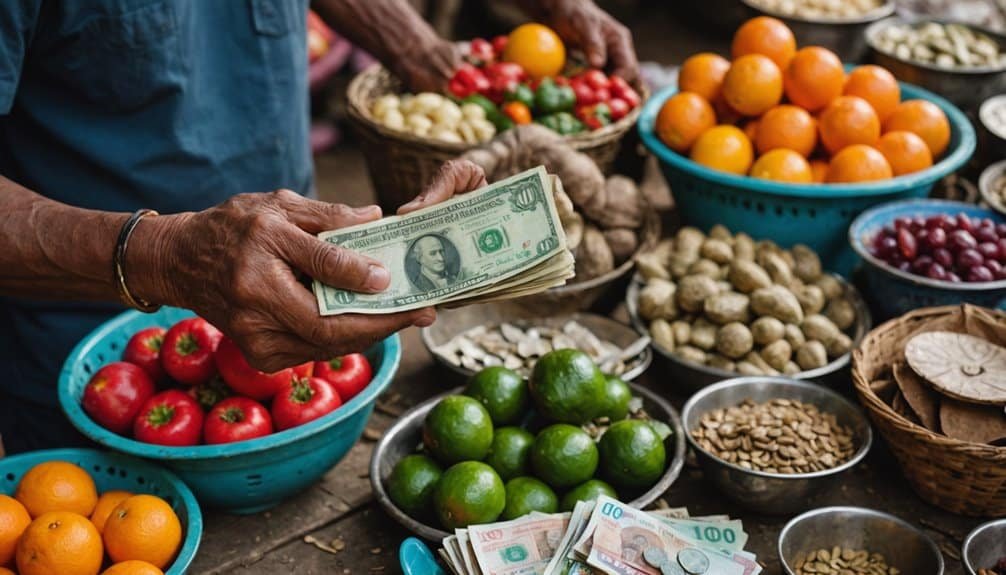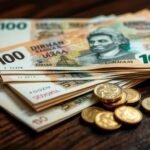
As you plan your trip to Cambodia, understanding the local currency, the Riel, will help you navigate everyday transactions and make the most of your travel experience. Cambodia operates a dual currency system with the Riel and US dollars. For small purchases and tips, carrying a mix of both is advisable. Major tourist areas typically accept US dollars, while local markets prefer Riel. The exchange rate is approximately 4,032 KHR per USD, with fluctuations possible, so it's best to set exchange rate alerts. To smooth out your financial journey in Cambodia, familiarize yourself with the ins and outs of the Riel.
Key Takeaways
- The Cambodian Riel is the national currency, featuring cultural heritage landmarks and icons, with a dual system alongside the U.S. Dollar.
- Riel is primarily used for transactions under $1, while U.S. Dollars dominate in tourist areas and larger establishments.
- The mid-market exchange rate is approximately 4032 KHR per USD, with currency stability and minor fluctuations observed.
- Carry a mix of U.S. Dollars and Riel for local payments, and exchange USD to KHR before travel for better rates.
- Riel denominations include coins and banknotes, with traditional markets commonly tagging prices in Riel for small transactions.
Understanding the Cambodian Riel
Maneuvering the world of currency in Cambodia can be a bit of a challenge, especially for foreign visitors. The Cambodian Riel holds significant cultural and historical importance, symbolizing the country's rich heritage.
Introduced in 1953, the Riel's design and features reflect this heritage, with banknotes featuring various landmarks and cultural icons, such as King Norodom Sihanouk and the Bakong Temple.
The Riel's significance also lies in its representation of the country's independence and resilience, particularly after its reintroduction in 1980 following the fall of the Khmer Rouge. Its dual currency system has led to the widespread use of the U.S. dollar, especially in urban and tourist areas, alongside the dollarization of the Riel.
Riel symbolism is evident in its depiction of national symbols, like the Independence Monument and Angkor Wat, on coins and banknotes, showcasing Cambodia's history and identity.
Understanding the Riel's importance can help you appreciate the country's culture during your visit.
Currency Exchange and Rates
As you plan your trip to Cambodia, it's crucial to stay on top of the current exchange rates to make the most of your money. The mid-market exchange rate is approximately 4032 Cambodian Riels per USD as of December 2024, with a relatively stable rate over the past week. The Riel's appreciation since 2000 has made it a more stable currency over time. You'll have several options for exchanging currency, including licensed money changers and banks, but it's worth noting that money changers in larger cities tend to offer better rates than banks.
Current Exchange Rates
When traveling to Cambodia, you're likely wondering what the current exchange rates are. The exchange rate for 1 KHR is approximately 0.0002482 USD as of December 6, 2024.
To give you a better idea, here are some approximate exchange rates:
- 1 USD ≈ 4,000 KHR
- 10 USD ≈ 40,000 KHR
- 50 USD ≈ 200,000 KHR
- 100 USD ≈ 400,000 KHR
Cambodia's currency has shown remarkable stability, with only minor fluctuations over the past week.
The exchange rate has remained relatively stable over the years despite inflation in Cambodia, reflecting the country's currency stability.
Exchange trends indicate that the KHR to USD rate has been steady, making it easier for visitors to plan their expenses.
You can also stay informed about market changes by setting exchange rate alerts for the KHR to USD rate, receiving daily updates via email alerts for your preferred exchange rates.
Currency Exchange Options
You've got your current exchange rates – now it's time to figure out where and how to exchange your money in Cambodia. You have several options, including banks, exchange booths, hotels, and local markets.
For safe transactions, opt for reputable services like Huy Keang Currency Exchange, Apsara Exchange, or ABA Bank. Compare rates between different providers to guarantee the best deal, and check for conversion fees and hidden markups.
It's also recommended to have some cash in local currency for small purchases and tipping. Exchanging US Dollars to Cambodian Riel before traveling can often yield better exchange rates and lower overall costs. Consider using trusted exchange booths or local banks for competitive rates.
To avoid scams, follow currency exchange tips and always choose reputable services for your transactions.
Cambodian Money in Circulation

Cambodia's official currency, the Riel, has experienced significant growth in circulation over the last decade, with an average annual increase of 14% – a reflection of the increasing demand for the local currency in the country's economy.
The total amount of Riel in circulation has increased from about 3.8 trillion to more than 14 trillion over the past 10 years. The National Bank of Cambodia (NBC) has been actively promoting the use of Riel through campaigns and regulations, which includes traditional markets primarily tagging prices in Riel for small transactions.
As a visitor, you'll encounter various Riel denominations, including:
- Coins: 50 riels, 100 riels, 200 riels, and 500 riels
- Small banknotes: 50 riels, 100 riels, and 500 riels, commonly used for small purchases
- Medium banknotes: 1,000 riels and 2,000 riels, suitable for everyday transactions
- Large banknotes: 5,000 riels, 10,000 riels, and higher denominations, often used for larger purchases
History of the Cambodian Riel
When you're in Cambodia, it's interesting to learn about the history of the riel, the country's national currency.
You'll find that the first riel was introduced in 1953, following Cambodia's independence from France, and it replaced the piastre de commerce at par.
This initial issuance marked the beginning of Cambodia's independent monetary system, giving the country control over its own economy.
The riel was later reintroduced in 1980 after the Khmer Rouge regime fell, with an initial value set at 4 riel per USD.
First Riel Issuance
Cambodia's Riel: A Visitor's Guide to Cambodian Money
First Riel Issuance (History of the Cambodian Riel)
Independence from French colonial rule marked a significant turning point in Cambodia's economic journey.
As you learn about the country's currency, it's crucial to understand the first riel issuance. In 1953, Cambodia introduced the riel, replacing the Indochine piastre. The first riel design featured dual-denominated banknotes in piastre and riel, with the riel at par with the piastre.
To picture the initial banknotes, consider these key denominations:
- 1 riel
- 5 riels
- 10 riels
- 50 riels
The name of the currency, the Mekong river fish, has an interesting origin and is believed to be the possible derivation of the term "riel". These banknotes were circulated alongside the piastre for the first few years, reflecting the country's gradual shift to its new currency.
The introduction of the riel held historical significance as a step toward Cambodia's economic independence. It's fascinating to see how the country's currency evolved over time, reflecting its growth and development.
Loss of Monetary System
Something was horribly wrong in Cambodia between 1975 and 1979.
During this period, the Khmer Rouge systematically destroyed the country's financial infrastructure, including markets, trade, money, and banking. The National Bank of Cambodia's headquarters was bombed, and a functioning financial system ceased to exist.
You'll find that commercial transactions were mainly conducted through a barter system or using rice, gold, and later, Vietnamese dong. This led to a complete monetary collapse, resulting in a loss of monetary system and currency use in Cambodia.
In recent years, efforts have been made to promote the use of the Cambodian riel, including its international exchange at select financial institutions, such as Travelex counters in Singapore's Changi Airport.
Practical Uses of the Riel

Maneuvering Cambodia's mixed currency landscape can be a bit tricky, but understanding the practical uses of the Riel will make a big difference in your daily transactions.
When using the Riel, you'll notice that it's mainly used for amounts less than $1. The official currency is Riel, but US Dollars dominate transactions.
Here's what you should know about Riel transactions and currency preferences:
- Change in Riel: Expect change for amounts less than $1 in Riel.
- Local Shops: Some smaller local shops and markets prefer or only accept Riel.
- Tourist Areas: US Dollars are widely accepted in tourist areas, hotels, restaurants, and larger shops.
- Merchant Preferences: Ask about the preferred currency before paying, as merchants may have preferences.
This knowledge will help you navigate Cambodia's unique currency landscape and make informed decisions about using the Riel in your daily transactions.
Visitor's Currency Guide
Now that you're familiar with the practical uses of the Riel, it's time to take a closer look at the bigger picture – Cambodia's unique currency landscape as a whole. Cambodia operates on a dual currency system, where both the Riel and the US dollar are widely accepted. However, currency preferences can vary depending on the situation and location. When traveling to Cambodia, it is crucial to have a mix of US dollars and Riel for local payments, especially when visiting rural areas or local markets. When exchanging currency, be aware that the exchange rate is approximately 4,000 riel to 1 USD.
| Location | Local Payment | Currency Preference |
|---|---|---|
| Tourist Areas | Widely Accepted | US Dollar |
| Local Markets | Limited Acceptance | Riel |
| Border Towns | Variable | Thai Baht/Vietnamese Dong |
| Countryside | Limited Acceptance | Riel |
| Hotels and Restaurants | Widely Accepted | US Dollar
Conclusion
You now hold the key to exploring Cambodia's financial landscape. The Cambodian Riel, once a mysterious entity, has become a familiar friend. As you wander through bustling markets and ancient temples, the riel's intricately designed notes dance in your hands. The rustle of 100-riel bills and the clink of coins become a symphony of local life, harmonizing your journey with the vibrant rhythms of Cambodia.







Has anyone considered that the fluctuation of the Cambodian Riel might be affecting local businesses? Thoughts?
Interesting read, but dont you think Cambodia’s economy would benefit more from fully adopting the US dollar instead of dual currency?